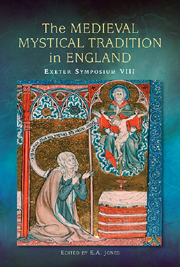 The Medieval Mystical Tradition in England
The Medieval Mystical Tradition in England Published online by Cambridge University Press: 05 July 2013
The Meditaciones of the Monk of Farne remain curiously untouched. W. A. Pantin wrote an excellent article on them in 1944. David Hugh Farmer published an edition of the Latin text in the late 1950s, followed some forty years later by a Benedictine translation. But apart from this they seem to have shot beneath everyone's radar, only ever mentioned in passing as a relatively late example of an insular tradition of Latin meditation from which the vernacular mystics eventually triumphantly emerge. So, their Latinity has done them a marked disservice. However, there remains much more to say about these texts, not least with respect to their sophisticated content, passages of mysticism, and substantial size, and I would argue that they deserve to be written back into the master narrative of late-medieval devotional and mystical literature in a fairly prominent way.
This essay will offer a brief description of the texts themselves, followed by remarks on their position within a north-eastern tradition of Cuthbertine spirituality, their affinities with Richard Rolle's writings, and their use by the Durham Benedictines during the fifteenth century. The ‘Monk’ is a monk solitary from Durham Benedictine priory, living in a hermitage on the island of Inner Farne, off the north-eastern coast of England. Probably or possibly he is John Whiterig, who is known to have occupied the hermitage between 1363 and 1371.
To save this book to your Kindle, first ensure [email protected] is added to your Approved Personal Document E-mail List under your Personal Document Settings on the Manage Your Content and Devices page of your Amazon account. Then enter the ‘name’ part of your Kindle email address below. Find out more about saving to your Kindle.
Note you can select to save to either the @free.kindle.com or @kindle.com variations. ‘@free.kindle.com’ emails are free but can only be saved to your device when it is connected to wi-fi. ‘@kindle.com’ emails can be delivered even when you are not connected to wi-fi, but note that service fees apply.
Find out more about the Kindle Personal Document Service.
To save content items to your account, please confirm that you agree to abide by our usage policies. If this is the first time you use this feature, you will be asked to authorise Cambridge Core to connect with your account. Find out more about saving content to Dropbox.
To save content items to your account, please confirm that you agree to abide by our usage policies. If this is the first time you use this feature, you will be asked to authorise Cambridge Core to connect with your account. Find out more about saving content to Google Drive.